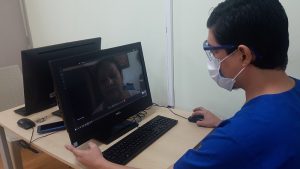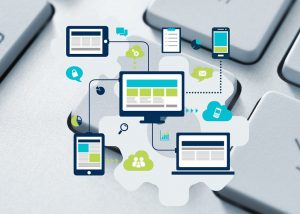15 COVID-19 and Technology in Healthcare
Jordan Kinzler
Introduction
The Coronavirus spread across the globe in 2020, and it is causing many parts of society to adopt new technologies in order to deal with the new reality created by the pandemic. One area of society, the healthcare industry has been especially affected by the COVID-19 pandemic. Due to COVID-19 being a medical issue that has infected tens of millions and killed over a million people worldwide, the healthcare industry is at the forefront of the fight against this highly contagious virus. COVID-19 has forced healthcare providers to make many changes to their practice. It particular, it has greatly impacted the use of technology in the healthcare industry. Changes brought by COVID-19 include the emergence of tele-health calls on Zoom, more incorporation of digital technologies into medical practice, the wide use of infrared thermometers, and the use different types of masks by healthcare providers.
Connection to STS Theory
One Science and Technology Studies theory that can be applied to the Coronavirus pandemic is the Actor-Network Theory. The Actor-Network Theory states that everything in our world is impacted and influenced by both human and non-human factors. This theory applies to the pandemic, which has had great waves of impact on all aspects of life around the world. COVID-19 has impacted the health care industry in many ways. Hospitals are now overflowing with cases and the health industry is in a race to find a vaccine to combat the virus. The pandemic is a non-human actor that is affecting and influencing society, but the ways that people, particularly those in the health industry and politicians are handling this crisis is also affecting society, which would be human influence.
Another Science and Technology Studies theory that can be applied to the pandemic is the Path Dependency Theory. The path dependency theory suggests that events are often shaped by a particular series of previous events and that these previous events can constrain or limit the outcomes of future events. The Coronavirus pandemic has definitely limited the options for humans going forward. It has changed the path of the world as a whole and for all individuals as well. For the healthcare system, its path has been constricted mostly to dealing with the Coronavirus and developing a vaccine to stop it. Many aspects of the healthcare system have been pushed into an online path due to the high contagiousness of COVID-19.
Telehealth

Due to the contagiousness of the Coronavirus and the increased dangers of the disease spreading when people are in close proximity, many healthcare activities have been moved to a virtual setting. For example, many medical visits, such as medication management, consultations, and even follow up visits have been moved to virtual video calls. Patient monitoring has also moved partially to a digital setting, and some patients can now be monitored from the comfort of their own homes using devices such as blood pressure monitors, digital scales, oximeters, and heart rate monitors that are connected to online platforms. These devices allow doctors to monitor a patient’s conditions from home, and they do not need to go into the office and risk potential infection (Wosik et al.).
Before the coronavirus, the total percentage of medical visits conducted virtually was less than one percent. They have greatly increased during the pandemic and in some practices make up almost seventy percent of the total number visits. In addition to tele-health visits and home patient monitoring, texting platforms and eConsults are also being used by healthcare providers to get information to patients and communicate with them from home or other safe environments (Buckley). These technologies and practices help limit in person exposure to potential infected persons in medical offices and increases the hours that patients can contact and be answered by medical professionals.
To ensure that new technologies are better incorporated into the healthcare system, the US Congress has lifted many previous legal provisions that restrained the use of tele-health for Medicare users. However, more needs to be done to allow full implementation of the new technologies being rapidly incorporated into the healthcare system. Although technologies such as tele-health visits, patient monitoring from home, and texting platforms are very helpful in limiting the spread of COVID-19, there are a lot of people who don’t have access to them because they either do not have health insurance or enough insurance coverage. These people may not seek medical aid even when experiencing COVID-19 symptoms because they cannot afford the cost of the medical aid. This leads to an increase in the spread of the virus. Some people may also not seek medical aid due to a lack of primary care centers in their area. These drawbacks in the American healthcare system have been magnified by the Coronavirus (Seervai).
Digital Technologies

Digital technologies are being used to combat the spread of COVID-19 by collecting data, predicting future trends, and even maximizing the effectiveness of limited amounts of Coronavirus tests. The Internet of Things is being used to collect Coronavirus data from all over the world and sites such as Worldometer are displaying this data in real time. Data on the site include the current number of infected people in the world, numbers of deaths, people in critical condition, and the number of people who have recovered from COVID-19. Global databases are also being used to create models on the current rate of infection and predict the future number of Coronavirus cases in order to guide policy makers on their decisions making. These models can be used to help make informed decisions for future pandemic preparations, like when to implement restrictions or loosen them in order to slow the spread and ultimately eliminate the coronavirus.
AI and deep learning can also be used to create algorithms for conducting initial COVID-19 screenings, which ask targeted questions to people in order to determine if they should be tested for the virus. This allows the limited amount of Coronavirus tests in some countries to be used most effectively. One of the most important things the healthcare system has implemented during the Coronavirus pandemic is the use of digital technologies to spread safety tips and guidelines to the public. Technology like social media can be used to offer the public advice on how to stay safe and avoid getting infected with COVID-19. These tips include washing hands frequently, staying six feet apart from other people, wearing a mask in public places, and other suggestions like not touching your eyes, nose, or mouth, disinfecting commonly touched objects and surfaces, and most importantly staying home when possible (Ting et al.).
However, the benefits provided by technology are often diminished by the refusal of humans to heed the advice they provide. Even with predictions of future infections from the data collected, some isolation mandates and quarantine restrictions have been lifted against the better judgement of health officials due to politicians giving in to complaints from the general public. Many members of the public also don’t follow safety tips related to COVID-19.
Thermometers and Masks
Along with online technologies being incorporated into the healthcare system, some everyday items are also being widely used in response to the Coronavirus pandemic. These which include infrared thermometers and a multitude of face masks and shields. Infrared thermometers are now being used in businesses and places of work to check for body temperatures over 100.4 F, which can be a sign of COVID-19. They allow temperature to be taken without touching a person, and limit the risk of spreading the virus (United States Food and Drug Administration).
Since April of 2020 many places in the US have had a mask mandate in place. Masks can be anything from medical grade N–95, cloth masks, face shields, and even a bandana tied around the face can be a makeshift mask. All masks provide some sort of protection, but some offer more protection than others. To provide the most protection from COVID-19, masks should be worn to cover both the nose and mouth and without large gaps in the sides. Neck gaiters, bandanas, and cloth masks with valves do not work as well in keeping out COVID-19 as medical grade and multilayer cloth masks. Face shields do not keep the virus out. If they are to be worn a face mask should be worn underneath the face shield. The most common type of mask worn are cloth masks, which mostly stops the person wearing them from spreading the virus. They aren’t as effective in preventing the person wearing them from being infected, unlike the medical grade masks. Masks should be worn at all times where the six feet distancing cannot be guaranteed. This includes in places business, grocery stores, places of work, restaurants, schools, and on public transportation. (Maragakis)
History of Masks
Masks have been used in the past and in other parts of the world in the present to stop the spread of diseases. As early as the seventeenth century bird-like plague masks were used to keep bad smells, which were thought to carry the plague from reaching the nose and mouth. Herbs and spices were placed in the nose of the masks to block the foul smells. The next instance of widespread mask wearing in order to prevent the spread of a disease was during the Influenza Pandemic. All over the world people donned masks to prevent the spread of the Spanish flu, but just like today some were reluctant to do so and refused to wear their masks despite mandatory mask orders being in place. In China and Japan masks have been widely worn since the early twentieth century. In China a variety of factors, including a 1910 pneumonic plague outbreak, fears of germ warfare spread by state propaganda, the SARS epidemic and smog in cities have led many to wear masks in regular life. In Japan masks have even become a symbol of modernity and politeness (Carstairs).
Conclusion
Due to the COVID-19 pandemic, the healthcare industry has increased its use of technologies, both digitally and physically. Telehealth visits, digital technologies, infrared thermometers, and face masks have seen increased use in healthcare practice as a response to Coronavirus. These new technologies have been rapidly incorporated, and they will most likely be a part of the healthcare system even after the virus is gone. The healthcare industry and the world will be forever impacted, both positively and negatively by this global event.
References
Buckley, Melissa. “Technology’s Emerging Role in the COVID-19 Response.” California Health Care Foundation, 1 Jul. 2020, https://www.chcf.org/blog/technologys-emerging-role-covid-19-response/. Accessed 12 Nov. 2020.
Carstairs, Catherine. “A brief history of masks from the 17th-century plague to the ongoing coronavirus pandemic.” The Conversation, 6 Sep. 2020, https://theconversation.com/a-brief-history-of-masks-from-the-17th-century-plague-to-the-ongoing-coronavirus-pandemic-142959. 1 Dec, 2020.
Maragakis, Lisa. “Coronavirus Face Masks & Protection FAQs.” Johns Hopkins Medicine, 20 Aug. 2020, https://www.hopkinsmedicine.org/health/conditions-and-diseases/coronavirus/coronavirus-face-masks-what-you-need-to-know. Accessed 12 Nov. 2020.
Seervai, Shanoor. “Coronavirus Reveals Flaws in the U.S. Health System.” The Commonwealth Fund, 6 Mar. 2020, http://www.commonwealthfund.org/publications/podcast/2020/mar/coronavirus-reveals-flaws-us-health-system?gclid=Cj0KCQjwtsv7BRCmARIsANu-CQc-mgWcNYSw7Ink6ZdCzzKaxf-5LiuwNo4cvm2FZLqkXcO0g_NAjEMaAtSJEALw_wcB. Accessed 12 Nov. 2020.
Ting, Daniel, et al. “Digital technologies in the public-health response to COVID-19.” Nature medicine, 27 Mar. 2020, https://www.nature.com/articles/s41591-020-0824-5. Accessed 12 Nov. 2020.United States Food and Drug Administration.
“Non-contact Temperature Assessment Devices During COVID-19.” United States Food and Drug Administration, 12 Jun. 2020, https://www.fda.gov/medical-devices/coronavirus-covid-19-and-medical-devices/non-contact-temperature-assessment-devices-during-covid-19-pandemic. Accessed 12 Nov. 2020.
Wosik, Jedrek, et al. “Telehealth Transformation: COVID-19 and the Rise of Virtual Care.” Journal of the American Medical Informatics Association : JAMIA, vol. 27, no. 6, 2020, pp. 957-962. https://academic.oup.com/jamia/article/27/6/957/5822868. Accessed 12 Nov. 2020.
Images
“Doctor attending by teleconsultation” by Ceibos, is licensed under CC BY-SA 4.0
“Computer – Phone – Tablet – Technology” by Blue Coat Photos is licensed under CC BY-SA 2.0

